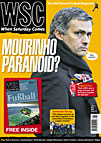 The Riverside Stadium could soon have a shiny new neighbour. But, as Daniel Gray explains, not everyone is convinced that a casino is what Middlesbrough needs
The Riverside Stadium could soon have a shiny new neighbour. But, as Daniel Gray explains, not everyone is convinced that a casino is what Middlesbrough needs
With the exception of signing Michael Ricketts, Middlesbrough have seldom been accused of gambling in Steve McClaren’s four-and-a-half-year tenure. Indeed, the football often displayed by Boro has been so cautious that few would have been surprised had McClaren erected a set of triangular yellow signs forbidding his midfielders from crossing the halfway line next to the home dug-out.
None the less, in recent months the club have overwhelmingly endorsed plans to redevelop the Middlehaven area adjacent to the Riverside Stadium into an “entertainment destination” centred around that pet project of New Labour and anathema to moralists everywhere, the “supercasino”. In future, instead of contending with mud piles and biting winds scything in from the North Sea, visitors tackling the long approach road to the ground by foot might be distracted by slot machines offering jackpots of up to £1 million. That this idea has materialised in the year that marks the 20th anniversary of Boro’s liquidation lends poignancy to a perhaps otherwise tawdry scheme.
When Steve Gibson moved Boro from the dilapidated if amiable Ayresome Park back in 1995, his decision was largely influenced by the promises of the government-backed Teesside Development Corporation (TDC) to regenerate the area surrounding the new ground. The Riverside was to be the catalyst for the type of waterside rebirth ubiquitous in post-industrial, Thatcher-bashed northern towns. It proved a catalyst for nothing other than local inertia, to the chagrin of the jilted Gibson.
Eleven years on, the TDC’s remit has been inherited by Tees Valley Regeneration (TVR) and under the auspices of the Gambling Act it appears that it may finally be about to honour its predecessor’s long-standing pledges. The act allows initially for the creation of one super, or “regional”, casino and 16 smaller establishments, although speculation lingers that as many as eight of the former could be constructed. The bid to bring the regional casino to Middlesbrough is being led by Aspers, a British-Australian alliance headed by multi-millionaire Damian Aspinall and James Packer, son of the late Kerry. Unremarkably, neither showed a passing interest in the fortunes of Teesside and Boro until the Gambling Act reached Westminster.
Their plans for “Aspers on the Quay” (which regrettably do not seem yet to include a name-change) are ambitious: £180m will, it is claimed, offer a return in addition to the casino of a 7,000-capacity sports and entertainment venue, luxury hotel, moveable road bridge and communal square with water garden included. In what would be the biggest single investment in Middlesbrough since Alen Boksic’s weekly wage, the Aspers development would dramatically alter the Riverside hinterland. With between 2,000 and 4,000 jobs resultant, there is little wonder Gibson and the club have implored Boro fans to text or email their support for the proposal and the Evening Gazette has declared that the plans represent a “breathtaking bonanza of opportunity”. Whether this bonanza will comprise short-term service-sector vacancies or genuine long-term development remains to be seen.
Opposition has been led by the Salvation Army and the Faith Communities Network, a group of local figures from across the religious spectrum, who expressed reservations about the impact on problem gamblers and the potential creation of new ones, the proximity of the casino to the planned new Middlesbrough College building, and the fact that many of the jobs created will be of a low-paid, low-skilled nature. Aspers asserted their credentials as a conscientious gambling organisation and have pledged to bankroll a Community Initiatives Fund, designed to cement the quay’s place in the local neighbourhood.
This debate has been echoed elsewhere. Five bids are heavily linked to clubs, with Elland Road, St Andrew’s, Ibrox, the Ricoh Arena and the Stadium of Light featuring in various versions of their respective councils’ propositions. It seems that where once clubs were totems of the community for what they meant to a town’s identity and shared experiences, now they are at the pivot because of the market their fans offer outside entrepreneurs.
In the case of the Riverside, though, given more than a decade with nothing except passing goods trains for company, Middlesbrough fans would find it extremely difficult to oppose any development. To be even talking of such plans indicates the scale of change affecting Boro, a club that were once locked out of their own ground, in those aforementioned 20 years, be it for better or worse.
From WSC 231 May 2006. What was happening this month